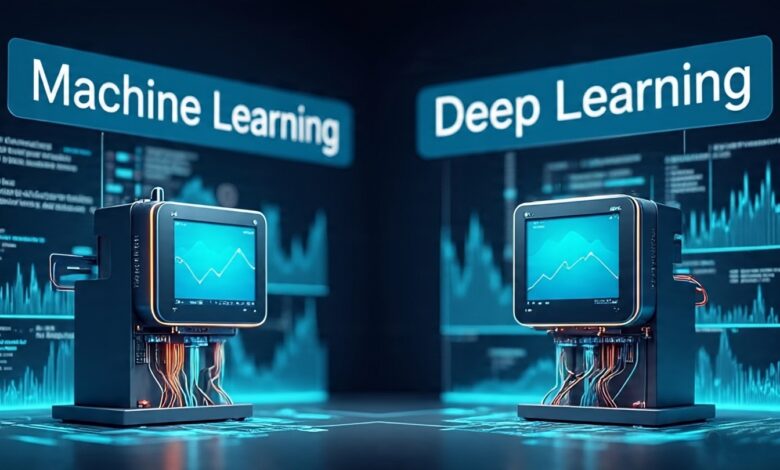Machine Learning vs Deep Learning: What’s the Real Difference?
Machine Learning vs Deep Learning explained: Compare algorithms, data requirements, performance, and real-world applications. Choose the right AI solution today.

Artificial intelligence is changing the way we live and work. At the heart of this change are two powerful tools: machine learning and deep learning. These terms often get mixed up, but they are not the same. Knowing the difference is key if you want to understand how AI really works.
In this guide, we’ll break down both technologies in a simple, clear way. You’ll learn what makes each one unique, when to use them, and how they’re shaping the future. Whether you’re a business leader planning your next move, a developer picking the best tools, or just curious about AI, this article is here to help you make sense of it all.
Machine Learning: The Foundation of AI
Machine learning represents a subset of artificial intelligence that enables computer systems to automatically learn and improve from experience without being explicitly programmed for every task. At its core, machine learning algorithms analyze data patterns, make predictions, and adapt their performance based on new information.
The machine learning process typically involves feeding large datasets into algorithms that identify patterns, relationships, and trends within the data. These algorithms then use these discovered patterns to make predictions or decisions about new, unseen data. This approach has revolutionized industries ranging from healthcare and finance to marketing and transportation.
Types of Machine Learning Algorithms
Traditional machine learning encompasses several distinct approaches, each suited to different types of problems and data structures.
Supervised Learning forms the backbone of many machine learning applications. In this approach, algorithms learn from labeled training data, where both input features and desired outputs are provided. Common supervised learning techniques include linear regression, decision trees, support vector machines, and random forests. These methods excel at classification tasks, such as email spam detection, and regression problems, like predicting housing prices.
Unsupervised Learning tackles scenarios where labeled data isn’t available. These algorithms discover hidden patterns within datasets without predetermined outcomes. Clustering algorithms like K-means and hierarchical clustering group similar data points together, while dimensionality reduction techniques like Principal Component Analysis (PCA) simplify complex datasets while preserving essential information.
Reinforcement Learning takes a different approach, where algorithms learn through interaction with an environment, receiving rewards or penalties based on their actions. This method has proven particularly effective in game playing, robotics, and autonomous systems where trial-and-error learning mimics human decision-making processes.
Key Characteristics of Machine Learning
Traditional machine learning approaches rely heavily on feature engineering, where domain experts manually select and transform raw data into meaningful features that algorithms can process effectively. This process requires significant human expertise and domain knowledge, making it both time-intensive and prone to human bias.
Machine learning models typically require structured data and perform well with smaller datasets compared to deep learning alternatives. The algorithms are generally more interpretable, allowing practitioners to understand how decisions are made and which features contribute most to predictions.
Deep Learning: The Neural Network Revolution
Deep learning represents a specialized subset of machine learning that mimics the structure and function of the human brain through artificial neural networks. These networks consist of multiple layers of interconnected nodes, each processing information and passing it to subsequent layers, creating a hierarchical learning structure.
The “deep” in deep learning refers to the multiple hidden layers between input and output layers. While traditional neural networks might have one or two hidden layers, deep learning networks can contain dozens or even hundreds of layers, enabling them to learn increasingly complex patterns and representations.
Neural Network Architecture
Deep learning networks utilize various architectural designs, each optimized for specific types of problems. Convolutional Neural Networks (CNNs) excel at image processing tasks, using filters to detect edges, textures, and complex visual patterns. These networks have revolutionized computer vision, enabling applications like facial recognition, medical image analysis, and autonomous vehicle navigation.
Recurrent Neural Networks (RNNs) and their advanced variants, including Long Short-Term Memory (LSTM) networks, specialize in sequential data processing. These architectures maintain memory of previous inputs, making them ideal for natural language processing, speech recognition, and time series prediction.
Transformer architectures represent the latest breakthrough in deep learning, particularly in natural language processing. These networks use attention mechanisms to process sequences more efficiently than traditional RNNs, powering modern language models and chatbots.
The Power of Representation Learning
Unlike traditional machine learning, deep learning algorithms automatically discover relevant features from raw data through representation learning. This capability eliminates the need for manual feature engineering, allowing networks to identify patterns that might be invisible to human experts.
Deep learning models learn hierarchical representations, where early layers detect simple patterns and deeper layers combine these simple patterns into increasingly complex concepts. In image recognition, for example, initial layers might detect edges and corners, while deeper layers recognize shapes, objects, and eventually complex scenes.
Machine Learning vs Deep Learning: Core Differences
The distinction between machine learning vs deep learning extends beyond mere technical specifications to encompass fundamental differences in approach, requirements, and applications.
Data Requirements and Processing
Traditional machine learning algorithms often perform well with smaller datasets, sometimes requiring only thousands of examples to achieve good performance. These algorithms can work effectively with structured data, such as spreadsheets and databases, and often benefit from careful feature selection and preprocessing.
Deep learning models, conversely, typically require massive amounts of data to achieve optimal performance. The complex nature of neural networks with millions or billions of parameters necessitates extensive training examples to prevent overfitting and ensure generalization. However, deep learning excels at processing unstructured data, including images, audio, and text, without requiring manual feature extraction.
Computational Resources and Infrastructure
The computational demands represent another significant difference in the machine learning vs deep learning comparison. Traditional machine learning algorithms can often run on standard computers or modest server configurations, making them accessible to organizations with limited technical infrastructure.
Deep learning models demand substantial computational resources, particularly Graphics Processing Units (GPUs) or specialized hardware like Tensor Processing Units (TPUs). Training complex deep learning models may require weeks or months of computation time on powerful hardware clusters, representing a significant investment in both time and resources.
Interpretability and Explainability
Machine learning models generally offer greater interpretability, allowing practitioners to understand decision-making processes and identify which features most influence predictions. This transparency is crucial in regulated industries like healthcare and finance, where understanding model behavior is essential for compliance and trust.
Deep learning models, while often more accurate, operate as “black boxes” where the decision-making process remains largely opaque. The complex interactions between millions of parameters make it challenging to explain why a particular prediction was made, limiting their use in applications requiring explainable AI.
Performance Comparison: When Each Approach Excels
The performance characteristics of machine learning vs deep learning vary significantly depending on the specific use case, data availability, and problem complexity.
Traditional Machine Learning Strengths
Machine learning algorithms excel in scenarios with limited data availability, where the additional complexity of deep learning cannot be justified. These approaches perform particularly well with structured, tabular data common in business applications, financial modeling, and scientific research.
The speed of training and inference makes traditional machine learning attractive for real-time applications and scenarios requiring quick iteration. The interpretability of these models also makes them suitable for applications where understanding decision-making processes is crucial.
Deep Learning Advantages
Deep learning demonstrates superior performance in complex pattern recognition tasks, particularly those involving unstructured data. Image recognition, natural language processing, and speech recognition have all seen dramatic improvements through deep learning approaches.
The ability to automatically discover relevant features from raw data makes deep learning particularly valuable in domains where manual feature engineering is challenging or where human experts may miss important patterns. This capability has led to breakthroughs in medical diagnosis, scientific discovery, and creative applications.
Real-World Applications and Use Cases
Understanding the practical applications helps clarify when to choose between machine learning vs deep learning approaches.
Machine Learning Applications
Traditional machine learning finds extensive use in business analytics, where algorithms analyze customer behavior, predict market trends, and optimize operations. Recommendation systems, fraud detection, and risk assessment often rely on machine learning techniques due to their interpretability and efficiency with structured data.
In manufacturing, machine learning algorithms monitor equipment performance, predict maintenance needs, and optimize production processes. The ability to work with sensor data and historical records makes these approaches particularly valuable in industrial settings.
Deep Learning Applications
Deep learning has revolutionized computer vision applications, enabling advanced image recognition systems used in autonomous vehicles, medical imaging, and security systems. The ability to process raw pixel data without manual feature engineering has made these applications possible.
Natural language processing represents another domain where deep learning excels. Modern chatbots, translation systems, and content generation tools rely on deep learning architectures to understand and generate human language with unprecedented accuracy.
Choosing the Right Approach: Decision Framework
Selecting between machine learning vs deep learning approaches requires careful consideration of multiple factors, including data availability, computational resources, interpretability requirements, and performance expectations.
Data Considerations
The nature and volume of available data significantly influence the choice between approaches. Structured data with clear relationships often benefits from traditional machine learning, while unstructured data like images, audio, and text typically requires deep learning approaches.
Consider the data collection and labeling costs, as deep learning models may require significantly more labeled examples than traditional machine learning approaches. The ongoing availability of data for model updates and retraining also affects the long-term viability of each approach.
Resource Requirements
Evaluate the available computational resources, including hardware, software, and human expertise. Traditional machine learning may be more suitable for organizations with limited technical infrastructure, while deep learning requires substantial investment in specialized hardware and expertise.
Consider the time constraints for model development and deployment. Machine learning models typically require shorter development cycles, while deep learning projects may require months of experimentation and optimization.
Performance and Accuracy Requirements
Assess the accuracy requirements for your specific application. While deep learning often achieves higher accuracy in complex tasks, traditional machine learning may provide sufficient performance for many business applications while offering additional benefits like interpretability and faster deployment.
Future Trends and Developments
The landscape of machine learning vs deep learning continues evolving rapidly, with emerging technologies blurring the traditional boundaries between these approaches.
Hybrid Approaches
Modern AI systems increasingly combine elements of both machine learning and deep learning, leveraging the strengths of each approach. Ensemble methods that combine multiple algorithms, including both traditional machine learning and deep learning models, often achieve superior performance compared to individual approaches.
Automated Machine Learning (AutoML)
AutoML platforms are democratizing access to both machine learning and deep learning by automating model selection, hyperparameter tuning, and feature engineering. These tools make advanced AI techniques accessible to organizations without extensive technical expertise.
Edge Computing and Model Optimization
Advances in model compression and optimization are making deep learning more accessible for deployment on edge devices and resource-constrained environments. These developments are expanding the practical applications of deep learning while maintaining the efficiency advantages of traditional machine learning.
Making the Strategic Choice
The decision between machine learning vs deep learning ultimately depends on your specific requirements, constraints, and objectives. Traditional machine learning remains the preferred choice for many business applications due to its interpretability, efficiency, and lower resource requirements.
Deep learning becomes essential when dealing with complex, unstructured data or when the highest possible accuracy is required. The investment in computational resources and expertise is justified by the superior performance in these specialized domains.
Success in AI implementation requires understanding that machine learning and deep learning are complementary rather than competing technologies. The most effective AI strategies often incorporate both approaches, selecting the optimal technique for each specific task within a broader system.
As artificial intelligence continues advancing, the distinction between machine learning vs deep learning may become less important than understanding when and how to apply each approach effectively. The key lies in matching the right technology to the right problem, considering all relevant factors including data, resources, requirements, and long-term strategic objectives.
The future of AI lies not in choosing sides in the machine learning vs deep learning debate, but in developing the expertise to leverage both approaches effectively, creating intelligent systems that combine the best of both worlds to solve complex real-world problems.











